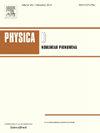Analysis of the autocorrelation function for time series with higher-order temporal correlations: An exponential case
IF 2.7
3区 数学
Q1 MATHEMATICS, APPLIED
引用次数: 0
Abstract
Temporal correlations in the time series observed in various systems have been characterized by the autocorrelation function. Such correlations can be explained by interevent time distributions as well as by correlations between interevent times or higher-order temporal correlations. Despite its importance, the impact of higher-order temporal correlations on the autocorrelation function has been largely unexplored. For studying such impact, we focus on the bursts, i.e., clusters of rapidly occurring events within short time periods, and positive correlations between consecutive burst sizes. We devise a model generating a time series with correlated burst sizes by employing the copula method. We successfully derive the general analytical solution of the autocorrelation function of the model time series for arbitrary distributions of interevent times and burst sizes when consecutive burst sizes are correlated. For the demonstration of our analysis, we adopt exponential distributions of interevent times and burst sizes to find that the analytical solutions are in good agreement with numerical simulations. Our approach helps us to understand how higher-order temporal correlations affect the decaying behavior of the autocorrelation function.
具有高阶时间相关的时间序列的自相关函数分析:一个指数情况
在各种系统中观测到的时间序列中的时间相关性已经用自相关函数来表征。这种相关性可以通过事件间时间分布以及事件间时间之间的相关性或高阶时间相关性来解释。尽管它很重要,但高阶时间相关对自相关函数的影响在很大程度上尚未被探索。为了研究这种影响,我们将重点放在突发上,即短时间内快速发生的事件簇,以及连续突发大小之间的正相关性。我们设计了一个模型,利用copula方法生成具有相关突发大小的时间序列。我们成功地推导了连续爆发规模相关时,对于任意间隔时间和爆发规模分布的模型时间序列自相关函数的一般解析解。为了证明我们的分析,我们采用了间隔时间和爆发大小的指数分布,发现解析解与数值模拟很好地吻合。我们的方法帮助我们理解高阶时间相关性如何影响自相关函数的衰减行为。
本文章由计算机程序翻译,如有差异,请以英文原文为准。
求助全文
约1分钟内获得全文
求助全文
来源期刊

Physica D: Nonlinear Phenomena
物理-物理:数学物理
CiteScore
7.30
自引率
7.50%
发文量
213
审稿时长
65 days
期刊介绍:
Physica D (Nonlinear Phenomena) publishes research and review articles reporting on experimental and theoretical works, techniques and ideas that advance the understanding of nonlinear phenomena. Topics encompass wave motion in physical, chemical and biological systems; physical or biological phenomena governed by nonlinear field equations, including hydrodynamics and turbulence; pattern formation and cooperative phenomena; instability, bifurcations, chaos, and space-time disorder; integrable/Hamiltonian systems; asymptotic analysis and, more generally, mathematical methods for nonlinear systems.
 求助内容:
求助内容: 应助结果提醒方式:
应助结果提醒方式:


